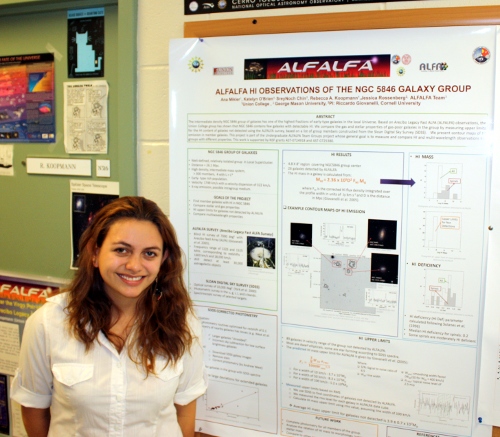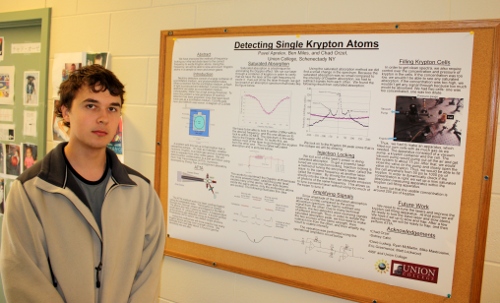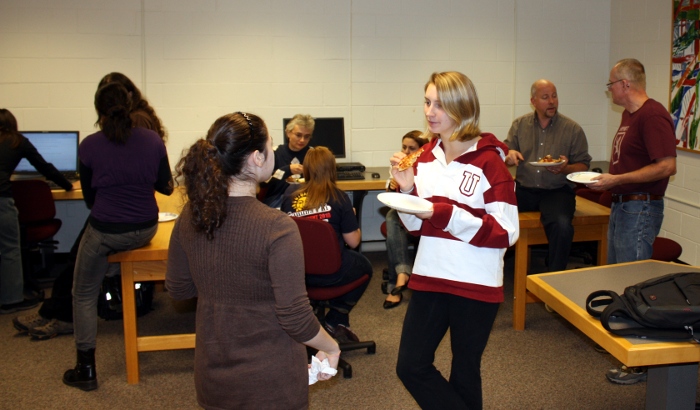Speaker: Prof. Rebecca Surman
Title: Astrophysical Alchemy: Creating the Heaviest Elements Within the Galaxy’s Biggest Explosions
Abstract: While the origins of the light (hydrogen, helium) and intermediate mass (carbon through iron) elements found in our solar system are well understood, we still don’t know where roughly half of the elements heavier than iron were made. From the solar system abundance pattern of these nuclei, we can tell they were synthesized in conditions of high temperature and free neutron density. However, where these extreme conditions are found astrophysically is still uncertain. Here we will discuss aspects of heavy element synthesis in two potential astrophysical sites: the neutrino-driven wind of core-collapse supernovae and hot outflows from compact object mergers.
As always, the colloquium will be at 12:40 in Room N304, with pizza and soda available at 12:20 for those attending the talk. For details of future colloquia, see the Fall 2010 colloquium schedule.
Speaker: Petros Thomas
Title: Carbonaceous Contamination on Extreme Ultraviolet Lithography Mirrors Due to Different Wavelengths of Light
Abstract: Extreme Ultraviolet Lithography (EUVL) is one the leading candidates as the next generation of lithographic technology for the semiconductor industry. One of the challenges of EUVL is the carbonaceous contamination of the multilayer EUV mirrors in the tool which reduces the reflectivity of the mirrors in the desired wavelength range. Carbonaceous contamination on optical surfaces due to light in hydrocarbon environment is a major problem in different applications such as synchrotron beam lines, astronomy telescopes, and recently in EUV lithography. Although the problem has been around for a long time, the basic mechanism of the contamination is still not fully understood. The contamination is localized to the region of the surface exposed to light in the presence of hydrocarbons. The hydrocarbons dissociate and leave carbonaceous film in the exposed region of the surface. Whether the dissociation of the hydrocarbons is caused by the incoming photons of the light or secondary electrons from the surface is not well known.
Using a Xe-plasma source which emits not only the desired wavelength near 13.5 nm (EUV light) but a wide range of out-of-band (OOB) wavelengths extending as far as the visible region, we studied the carbonaceous contamination rates of different wavelength regions. We have measured the wavelength dependence of carbon contamination on a Ru-capped mirror. These results are compared to contamination rates on TiO2 and ZrO2 capping layers.
Speaker: Petros Thomas
Title: Carbonaceous Contamination on Extreme Ultraviolet Lithography Mirrors Due to Different Wavelengths of Light
Abstract: Extreme Ultraviolet Lithography (EUVL) is one the leading candidates as the next generation of lithographic technology for the semiconductor industry. One of the challenges of EUVL is the carbonaceous contamination of the multilayer EUV mirrors in the tool which reduces the reflectivity of the mirrors in the desired wavelength range. Carbonaceous contamination on optical surfaces due to light in hydrocarbon environment is a major problem in different applications such as synchrotron beam lines, astronomy telescopes, and recently in EUV lithography. Although the problem has been around for a long time, the basic mechanism of the contamination is still not fully understood. The contamination is localized to the region of the surface exposed to light in the presence of hydrocarbons. The hydrocarbons dissociate and leave carbonaceous film in the exposed region of the surface. Whether the dissociation of the hydrocarbons is caused by the incoming photons of the light or secondary electrons from the surface is not well known.
Using a Xe-plasma source which emits not only the desired wavelength near 13.5 nm (EUV light) but a wide range of out-of-band (OOB) wavelengths extending as far as the visible region, we studied the carbonaceous contamination rates of different wavelength regions. We have measured the wavelength dependence of carbon contamination on a Ru-capped mirror. These results are compared to contamination rates on TiO2 and ZrO2 capping layers.

Ana Mikler ’12 worked with Professor Koopmann using the Arecibo radio telescope to measure the amount of radio emission from hydrogen gas in nearby galaxies.
Ana’s Poster (1.25MB PDF)

Pavel Aprelev ’13 spent four weeks working in Professor Orzel’s lab for the laser cooling and trapping of krypton. Pavel worked on improving the laser frequency stabilization system that allows the lasers to be tuned to exactly the right frequency for trapping metastable krypton atoms.
Pavel’s poster (717kB GIF)
Students and faculty gathered in the department on Thursday, September 16th for the fourth annual Summer Research Student Poster Session, with 18 students presenting 16 posters on their research activities over the summer.
Watch this space for more details about the students and their projects.
The annual Summer Research Poster session will be held Thursday, September 16th in the Department, from 12:20 pm to 1:40 pm. Pizza and soda will be available in room N304 for people attending the poster session. You can check out the list of presenters and poster titles to get an idea of the range of activities.
This is the official kick-off of the fall colloquium season. Come see the fascinating things our students did on their summer vacations.
Associate PRofessor Rebecca Surman was invited to present her research at two international workshops this summer. She gave a talk on Neutron capture in the r-process at the ExtreMe Matter Institute (EMMI) workshop on Neutron Matter in Astrophysics: From Neutron Stars to the r-Process in Darmstadt, Germany, and spoke about “Neutrinos and nucleosynthesis” at the NOW 2010 neutrino oscillation workshop in Conca Specchiulla, Italy. She also submitted a poster to the Nuclei in the Cosmos IX, July 19-23, in Heidelberg, Germany with collaborators from the University of Tennessee and Oak Ridge National Laboratory.
The colloquium coordinator for 2010-2011 is Prof. Jon Marr, and the complete Fall schedule is here.
News and Events in Union College Physics and Astronomy



